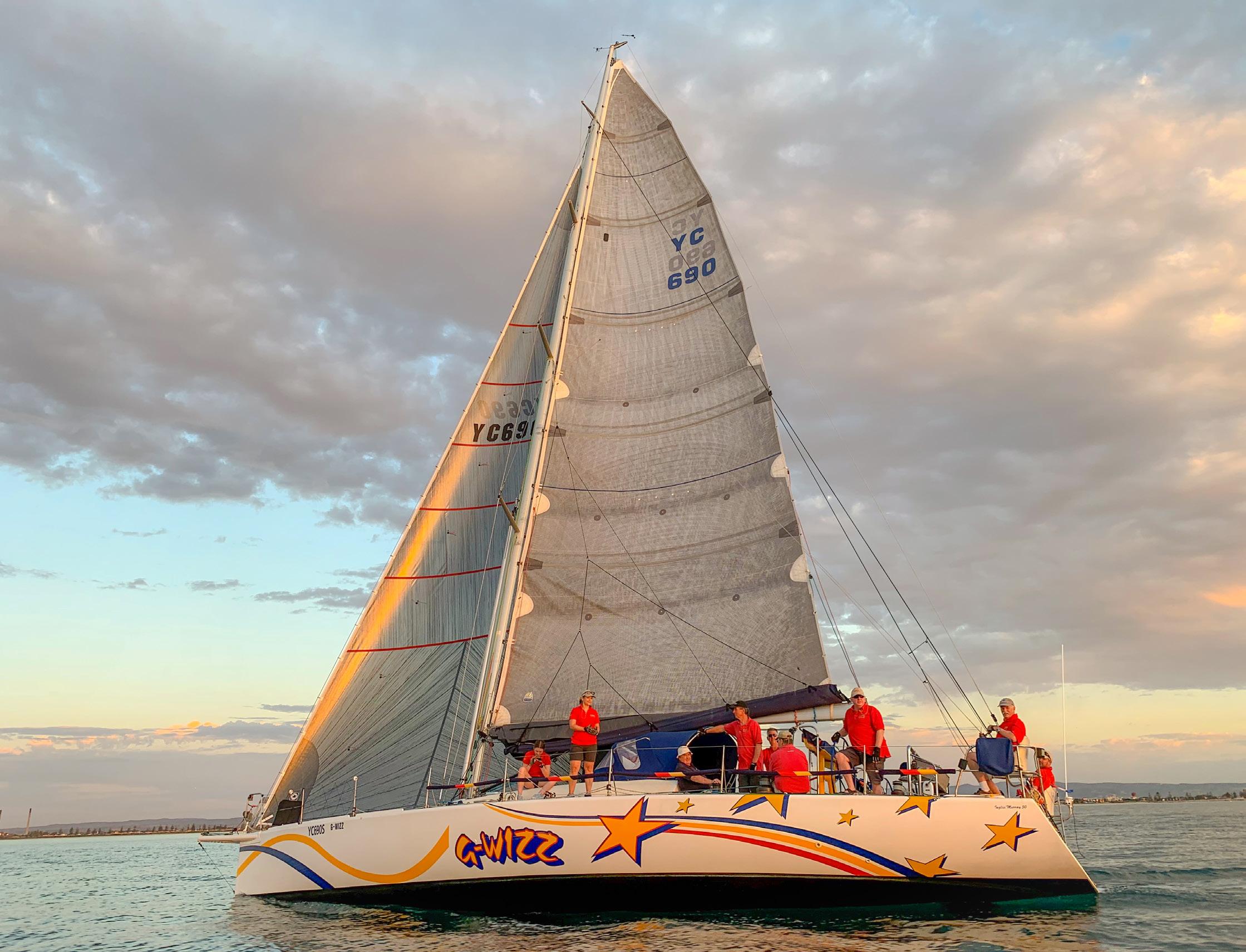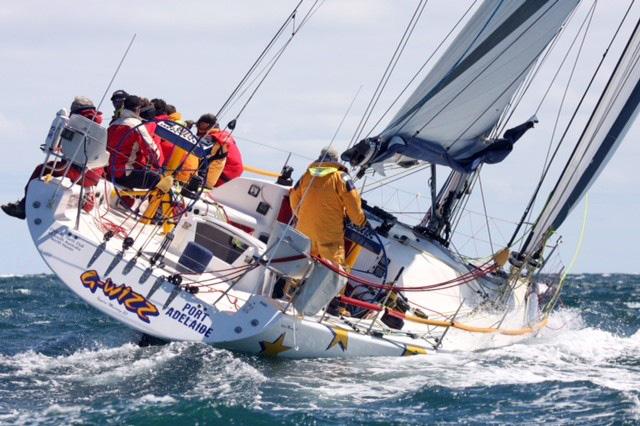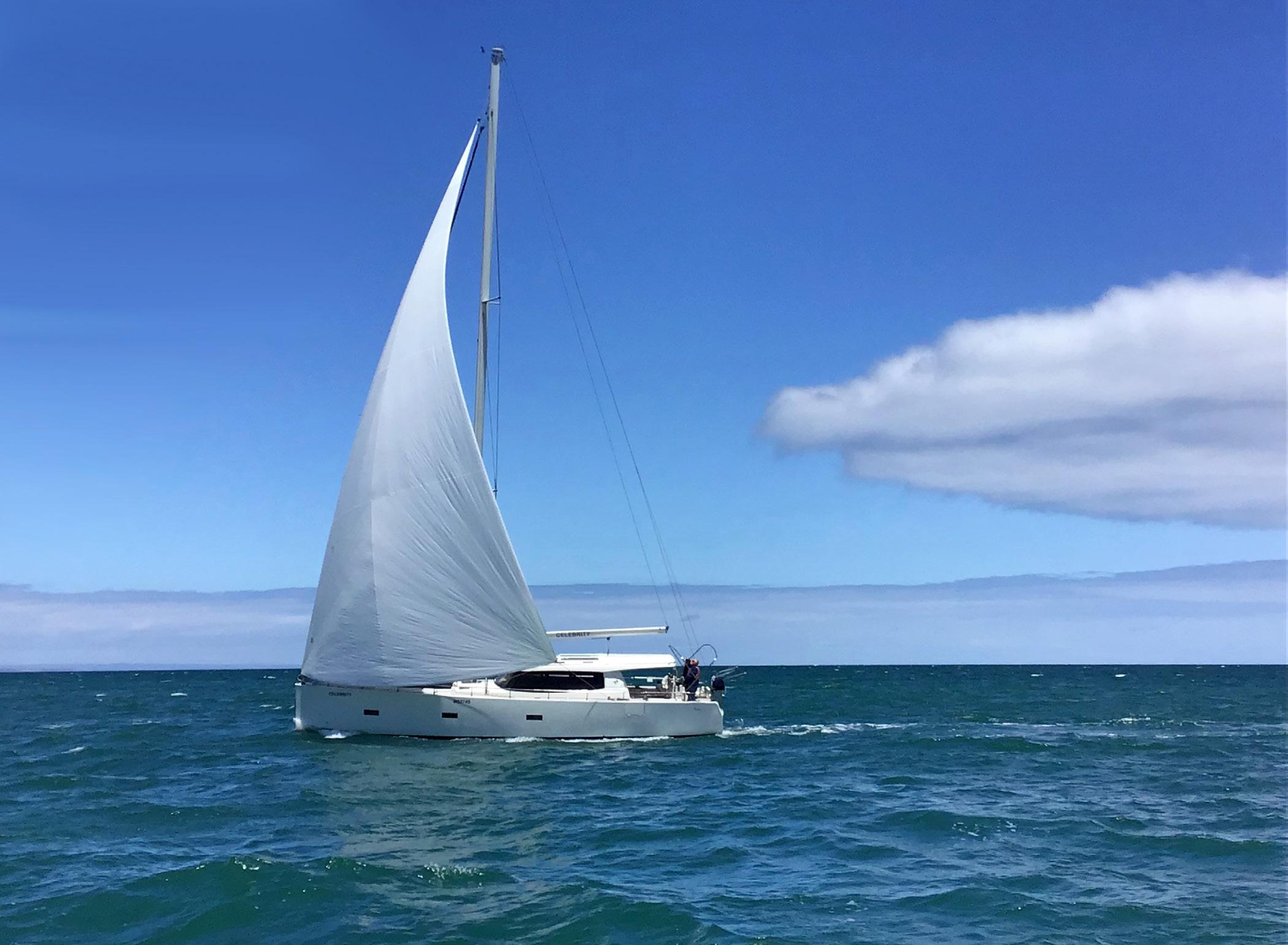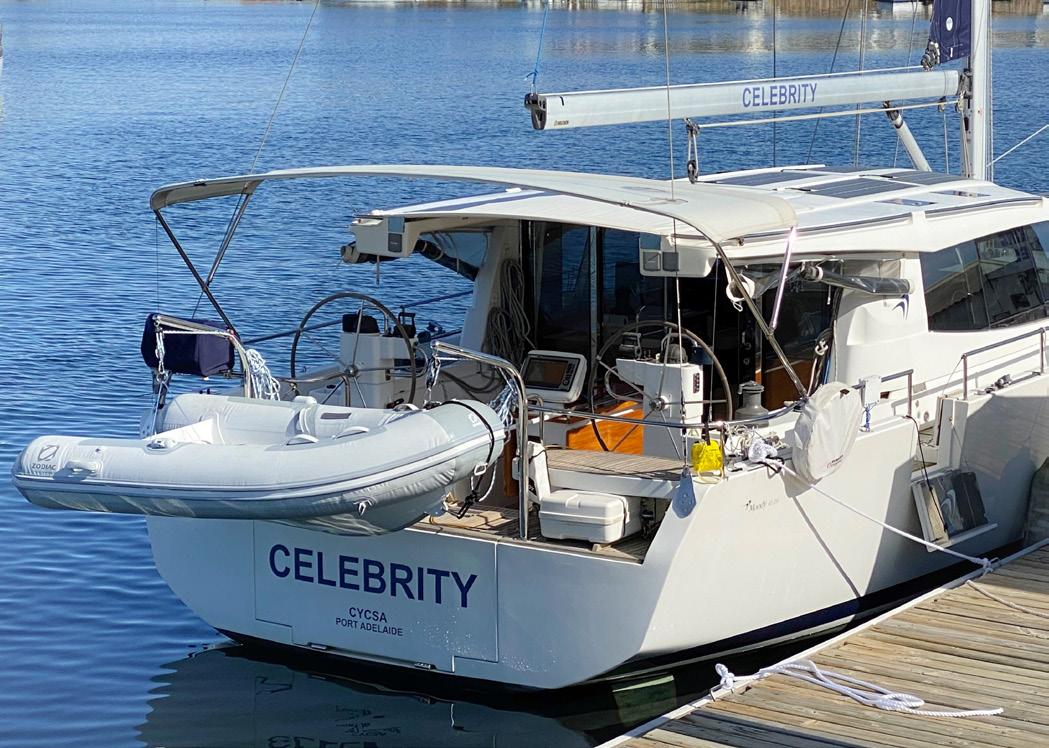
10 minute read
BOATS AT THE CLUB
This is another in the series of articles aimed at providing you with an insight into new boats and other boats of interest at the Club. Contact Pat Catley through the Club if you are interested in having your boat featured here.
On 1 May 2021 Greg and Carol Patten will have owned their Inglis yacht G-Wizz for twenty years. Greg kindly shared the yacht’s history with me. G-Wizz was built in 1993 by Mal Hart in Victoria and hand crafted from western red cedar. She was designed by the Queensland yacht designer Jim Inglis and started life as a 47 footer with a lifting keel. Within two years G-Wizz was back in Mal Hart’s factory and extended to 50 feet. Over the next few years more optimisations were made with a Murray designed rudder and a longer, fixed keel added in a toolmaker’s workshop in Queensland. A keel stepped mast was also added during that period. G-Wizz raced extensively up and down the New South Wales and Queensland coast until late 2000. Greg had been following the developments of G-Wizz over several years as he was keen to own an offshore Jim Inglis designed yacht and in early 2001 his nephew rang from Mooloolaba to say that G-Wizz was about to go on the market. Greg jumped on the next plane and after a very windy late afternoon sea trial made an offer which was accepted. Greg was very impressed with the quality of the vessel, especially how the fixed keel had been housed in the centre 30
case using only horizontal laid keel bolts. Having built two smaller yachts in his younger years Greg knew what to look for and played an active role in the survey. He flew back to Adelaide and with Carol’s support put together a team to sail G-Wizz the1600 nautical miles back home to Adelaide. In late May 2001, just before sundown, fully fuelled and provisioned, G-Wizz headed out over the Mooloolaba sandbar and into a 28 knot south-easter that built to over 30 knots during the night. Over the next few hours the crew discussed turning north and heading for Hamilton Island instead! The port stops for the trip home were planned to be Coffs Harbour, Sydney, Portland, Wirrina and Adelaide with the 3.3 metre fixed keel preventing refuge in bays along the way. The first two nights at sea allowed the crew to settle into some rough weather sailing whilst keeping well clear of the offshore longliners with many kilometres of fishing line. They also passed many pods of whales and dolphins heading north for the winter - a much better idea! Radio contact with prawn vessels told them the weather was the worst experienced for decades and when G-Wizz arrived in Coffs Harbour provisions were low with the crew needing a hot shower and sleep. They were greeted on the dock at 5.30am by a prawn fisherman with freshly cooked prawns for breakfast and a very firm congratulatory handshake. The
weather further deteriorated with winds getting up to 60 knots so the team spent four days trying out the restaurants in Coffs Harbour. Sailing down the east coast continued with winds ‘on the nose’. G-Wizz spent a week at the CYC in Sydney then from Sydney down the coast and into Bass Strait with winds blowing from the south up to 45 knots. The crew decided to go through The Rip and moored at the Mornington wharf for a couple of nights. The Rip was reasonably navigated at 2am as all commercial shipping had been postponed due to the weather. All the G-Wizz crew had to do was dodge the growing number of commercial ships hovering around in the white water south of the entrance waiting for the wind to abate. After a well-earned break and again heading through The Rip they sailed into more Bass Strait headwinds. G-Wizz eventually headed along the South Australian coast to Robe where they spent two nights doing some repairs. They left Robe only to encounter a 25 knot northerly which stayed until arriving at North Haven in early June 2001. One of Greg’s crew was very keen to ensure they had plenty of food on board and at each port would store some extra goodies ‘just in case’. When the yacht was fully cleaned out upon arriving in Adelaide the cleaners found 13 carefully wrapped fruit cakes stored in various orifices of the yacht. By the time Greg and the crew got G-Wizz home to Adelaide the three week trip on the water was equivalent to three or four years of local racing experience. Over the next few years Greg and his crew won the CYCSA club championship Cock of the Walk, and did every Adelaide to Port Lincoln race from 2002 to 2014 inclusive. Several Adelaide to Port Vincent races and cruises were also undertaken with Carol and her girlfriends joining the crew on several occasions bringing along the mandatory ‘bubbles and nibbles’ as required. Greg operates G-Wizz like he runs his businesses and has several long term crew who know their roles and it is a pleasure to watch the crew preparing for a race at the dock and packing up afterwards. By 2010 Greg and Carol’s farming investments in the outback grew considerably and with their home at Kingfisher Lodge on the River Murray and the addition of MV Kingfisher (that’s another story) Greg decided to reduce his keelboat racing to twilights on Wednesday afternoons which coincides with visits to his head office in Adelaide and the occasional regatta. Saturday racing has now been replaced with weekends spent in the outback and river and driving the ski boat for their children and grandchildren. There currently is a shallow draft yacht being built for river and lake sailing. Over the past 20 years G-Wizz and the associated crew camaraderie has exceeded Greg’s expectations and provided a sailing experience for over 400 guests and crew at various times with the 2021 sailing season being Greg’s 53rd year of yacht racing. Greg has sailed the past 25 years with several of his current crew on board G-Wizz and his previous keelboat with several other crew coming up for 10 years on board G-Wizz. Greg has some ‘Rule of Thumb’ benchmarks for long term ownership of racing yachts Benchmark One is to undertake a major refit at least every 8-10 years. He has maintained this rule with the first refit in 2007 when G-Wizz was completely dismantled, placed in a shed and repainted with all deck fittings either checked or replaced. The second major refit was undertaken in 2012 when a brand new Volvo engine was fitted and a range of features added so G-Wizz could be sailed two-handed. This included adding water ballast tanks and associated fittings, electric winches and nearly one kilometre of wiring to allow for the winches to be controlled from pods at the steering position. Greg and one of his long term crew, Jeremy Barnes, designed and fitted the new system. In the early 2000s Greg read about technology developed in Europe whereby captive winches could be used on racing yachts which allowed for sheets and control lines to be wound both in and out and controlled electronically from the helm position. He did some engineering design work which included placing a load cell on all sheets and control lines in rough sea conditions to better understand working loads and found that he would need at least nine captive winches to set G-Wizz up to meet his vision. With each purpose built captive winch quoted at a minimum of $18,000 the vision looked doomed. As a farmer, Greg thought about captive winches that are used in various primary production applications and after some research found a perfect little stainless steel winch used by beekeepers to load their beehives onto trucks. As these winches were used commercially they were also safety approved for use in workplaces and being 12 volt they would be ideal. Greg approached his farm supply mate who happened to have 15 of these winches in stock. When he asked about the price the fellow said they were “pretty expensive” but if Greg purchased all 15 he could have them for $500 each! The winches were incorporated into the short-handed design and ten years later they are still working well. Short-handed sailing has opened up a whole new avenue for G-Wizz and shortly after the refit Greg and Jeremy obtained approval to do the Haystack Island race two-handed and came in second over the line having completed the race in just over 23 hours. They have gone on to do many two-handed races, once attempting a non-stop record from Adelaide to Auckland only to turn back when the winds gusted over 50 knots with the ensuing dust storm reaching all the way across the ditch from Sydney to Auckland. The record attempt was endorsed and monitored by the World Sailing Speed Record Council (WSSRC) which was monitoring the attempt from London and the authorities were very relieved when Greg and Jeremy decided to turn back with the winds eventually gusting over 60 knots in the Tasman Sea as the storm made its way to New Zealand. Greg and Jeremy still have thoughts of some long distance short-handed sailing and they will have to carefully accrue the necessary family-issued brownie points before anything serious is contemplated! There are still plenty of years left in G-Wizz to undertake some long distance sailing as the preparation process also included having the vessel registered as an Australian ship to allow for sailing in international waters. Benchmark Two is that annual maintenance on the yacht will cost 10% of the initial build price. This is a well discussed benchmark among keelboat yacht owners and after 20 years of keeping G-Wizz fully maintained for racing Greg can confirm that this formula is very accurate. For those yachties who purchase a cheap racing yacht, please remember that the 10% annual maintenance costs are not 10% of the purchase price but 10% of the original build price for the yacht! An interesting twenty years for G-Wizz with many more to come. Thank you Greg for giving me so much detail and I wish you many happy sailing and winning years ahead.

Pat Catley

Celebrity is a Moody 45 Deck Saloon-2011 owned by Richard and Megan Pope and was designed by British naval architect Bill Dixon. Moody Yachts were originally built in Swanwick, England but now are owned and built by Hanse Yachts in Germany. The Moody DS design is a departure from traditional yacht design in many ways as the theme is one level living with the galley, saloon and dining all on the same level. The Moody can be helmed from the outside port and starboard helm stations or from the internal helm station which provides great comfort when sailing on a cold night. There are no companionway steps and you step straight through the sliding glass doors into the saloon which includes a forward-facing NAV helm station then two shallow steps lead from the saloon down to the three cabins forward and two heads. Celebrity has an in-mast furling main and a self-tacking jib which makes the yacht very easy to handle under all conditions. Richard recently added a gennaker for light off the wind conditions. The sails and halyards are managed by two Lewmar 54 electric winches. There are a number of other features that make the Moody a pleasure to own including an anchor that lives concealed in a locker on the foredeck and very large lazarette at the stern where the tender can be stored. The large swim platform at the stern makes cooling off in hot weather a pleasure. Celebrity is powered by a 110 horsepower Yanmar and Genset. This is the third Celebrity owned by Richard and Megan.Their first Celebrity was a Swarbrick 11.1 and the second a Bavaria 50 and many adventures were had in both yachts. They tried to think of a different name for the Moody but Celebrity was the one they always preferred. A circumnavigation of Tasmania and a cruise to the West Coast to Ceduna have been part of their sailing adventures. Richard purchased his latest Celebrity in Melbourne about 12 months ago where she had been moored at the Docklands for a number of years and prior to that she had been in Pittwater. The sail back from Melbourne was a good breakingin experience and she handled well cruising at eight knots comfortably. Having sailed Celebrity around South Australia the plan is to cruise more extensively in the future. Thank you for the insight into your boat Richard and I wish you and Megan many happy sailing years ahead.
Pat Catley











